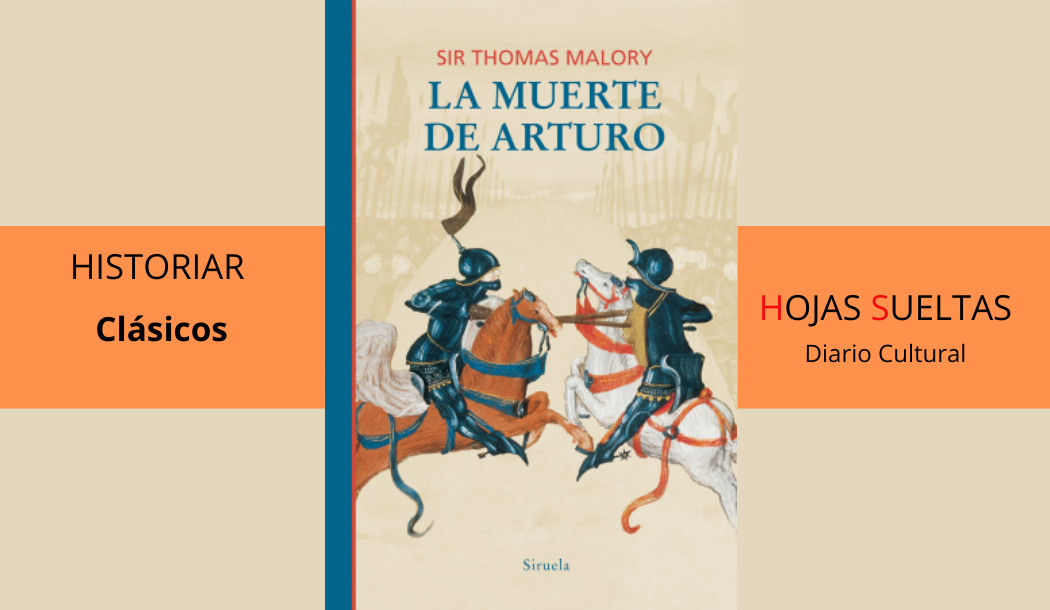 |
|
| Sinopsis de la Editorial
«La muerte de Arturo es, como ha destacado L. D. Benson, la única obra literaria escrita en Inglaterra entre Chaucer y Shakespeare que aún es leída por un amplio público con renovado fervor y placer. Creo que el mérito fundamental, es decir, lo que ha convertido este texto en un clásico, es su estilo moderno en el recuento de un fascinante material mítico». OPINION de HISTORIAR Sir Thomas Malory, un caballero inglés del siglo XV, escribió «La Muerte de Arturo» (originalmente titulada «Le Morte d’Arthur») mientras estaba encarcelado. Su vida estuvo marcada por las guerras de las Rosas y diversos conflictos que impregnaron su obra de un sentido profundo de tragedia y nobleza. Es una de las versiones más completas y detalladas de la leyenda del Rey Arturo y los Caballeros de la Mesa Redonda. La obra, escrita en inglés medio, narra la vida y las hazañas de Arturo desde su concepción y ascenso al trono, pasando por las aventuras y misiones de sus caballeros, hasta su caída y muerte. La obra está dividida en 21 libros, que relatan diferentes episodios y personajes dentro de la mitología artúrica. Entre los temas centrales se encuentran la nobleza, la traición, la lealtad, el amor cortés, la búsqueda del Santo Grial y el destino trágico de los héroes.
El estilo de Malory es directo y lleno de acción, con descripciones vívidas de batallas y encuentros románticos. Utiliza un lenguaje arcaico que, aunque puede ser desafiante para el lector moderno, añade autenticidad y un aire de antigüedad a la narrativa. «La Muerte de Arturo» ha tenido un impacto duradero en la literatura y la cultura popular. Ha influido en innumerables adaptaciones, desde libros y películas hasta series de televisión. La obra de Malory consolidó muchas de las historias artúricas y ayudó a popularizar la leyenda en el mundo anglosajón. Es una obra fundamental para entender la mitología artúrica y los ideales de la caballería medieval. La combinación de acción, romance y tragedia ofrece una visión completa y profunda de los héroes y sus dilemas. La obra de Malory sigue siendo relevante hoy en día, no solo como un documento histórico, sino como una fuente de inspiración y reflexión sobre la naturaleza humana y el destino. |
«Synopsis from the Publisher
The Death of Arthur,» as highlighted by L. D. Benson, is the only literary work written in England between Chaucer and Shakespeare that is still read by a wide audience with renewed fervor and pleasure. I believe that the fundamental merit, that is, what has made this text a classic, is its modern style in recounting a fascinating mythical material. HISTORIAR Sir Thomas Malory, a 15th-century English knight, wrote «The Death of Arthur» (originally titled «Le Morte d’Arthur») while he was imprisoned. His life was marked by the Wars of the Roses and various conflicts that imbued his work with a profound sense of tragedy and nobility. It is one of the most complete and detailed versions of the legend of King Arthur and the Knights of the Round Table. The work, written in Middle English, narrates the life and deeds of Arthur from his conception and rise to the throne, through the adventures and missions of his knights, to his fall and death. The work is divided into 21 books, which relate different episodes and characters within Arthurian mythology. Among the central themes are nobility, betrayal, loyalty, courtly love, the quest for the Holy Grail, and the tragic fate of the heroes. The Rise of Arthur: The first part of the work narrates how Arthur, son of Uther Pendragon, becomes king by pulling the sword Excalibur from the stone. It is a story of legitimacy and divine right, highlighting the idea of the leader chosen by God. The Knights of the Round Table: Much of the narrative focuses on the knights, such as Lancelot, Gawain, and Tristan, and their various adventures. These stories reflect the chivalric ideal and the conflicts between duty and personal desire. Forbidden Love: The relationship between Lancelot and Queen Guinevere is one of the emotional cores of the work. This love, though noble, triggers a chain of events that lead to the disintegration of the kingdom. The Quest for the Holy Grail: The central books narrate the quest for the Holy Grail, a symbol of purity and divine grace. This quest tests the knights and reveals their weaknesses and virtues. The Fall of Arthur: The final books focus on Mordred’s betrayal, the final battle, and Arthur’s death. This denouement is tragic and reflects the inevitability of fate and the fragility of human ideals. Malory’s style is direct and action-packed, with vivid descriptions of battles and romantic encounters. He uses archaic language that, although challenging for the modern reader, adds authenticity and an air of antiquity to the narrative. «The Death of Arthur» has had a lasting impact on literature and popular culture. It has influenced countless adaptations, from books and films to television series. Malory’s work consolidated many of the Arthurian stories and helped popularize the legend in the Anglo-Saxon world. It is a fundamental work for understanding Arthurian mythology and the ideals of medieval chivalry. The combination of action, romance, and tragedy offers a complete and profound vision of the heroes and their dilemmas. Malory’s work remains relevant today, not only as a historical document but as a source of inspiration and reflection on human nature and destiny. |
© Redacción Historiar



